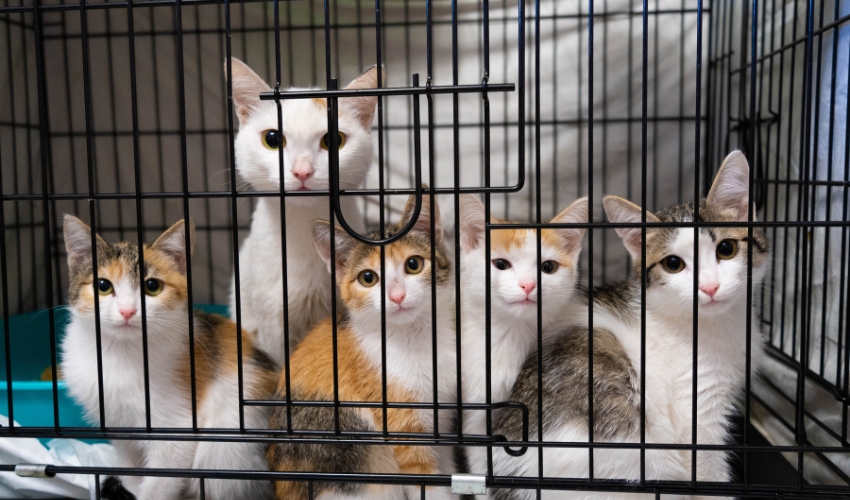Our homes are more than just shelters; they’re sanctuaries where our beloved pets should feel safe, secure, and content. Crafting a pet-friendly environment goes beyond providing the basics; it involves creating a space that promotes their physical and emotional well-being. In this comprehensive guide, we’ll delve into the intricacies of designing a home that caters to the needs of our feline companions, ensuring their safety, comfort, and happiness.
Identifying Potential Hazards:
Toxic Substances:
- Cats are curious creatures prone to investigating their surroundings with their mouths. Therefore, it’s crucial to eliminate potential hazards such as toxic plants (e.g., lilies, philodendrons), household cleaners containing chemicals harmful to pets, and human medications that can pose serious health risks if ingested.
- Store hazardous substances securely in cabinets or high shelves, ensuring they’re out of your cat’s reach. Consider opting for pet-safe cleaning products and consulting with your veterinarian about safe alternatives for pest control.
Electrical Safety:
- Electrical cords can be tempting chew toys for cats, but they pose significant dangers, including electrocution and burns. Safeguard your cords by using protective coverings, hiding them behind furniture, or investing in cord management solutions.
- If your cat shows persistent interest in cords, deter them with bitter-tasting sprays or cover them with PVC tubing to make them less appealing.
Small Objects and Choking Hazards:
- Cats are naturally inquisitive and may bat around small objects, putting them at risk of ingestion and choking. Keep items such as hair ties, rubber bands, and coins safely stored away, and regularly scan your home for any small objects that could be hazardous if swallowed.
- Secure loose items in drawers or containers, minimizing the risk of accidental ingestion. Opt for pet-friendly toys that are specifically designed to be safe for cats to play with.
Window Safety:
- Open windows provide fresh air and entertainment for cats, but they can also be dangerous if not properly secured. Install sturdy screens or window guards to prevent accidental falls, particularly if your windows are on higher floors.
- Consider placing cat-friendly window perches or shelves indoors, providing a safe vantage point for your cat to enjoy the view without the risk of injury.
Creating a Comfortable Living Space:
Cozy Retreats:
- Cats crave privacy and security, so it’s essential to provide cozy hideaways where they can retreat when they need some downtime. Invest in cat beds, condos, or covered hideaways placed in quiet, secluded areas of your home.
- Cats often seek out warm, snug spots for napping. Consider placing beds near radiators or providing heated cat beds to ensure your feline friend stays warm and comfortable.
Scratching Solutions:
- Scratching is a natural behavior for cats that helps them stretch, mark their territory, and maintain healthy claws. Provide a variety of scratching surfaces, including sisal scratching posts, cardboard scratchers, and carpeted cat trees, to satisfy your cat’s scratching instincts.
- Place scratching posts strategically around your home, focusing on areas where your cat spends the most time. Encourage your cat to use the posts by incorporating catnip or treats and praising them for appropriate scratching behavior.
Environmental Enrichment:
- Cats thrive on mental stimulation and enrichment, so it’s essential to provide opportunities for play, exploration, and sensory engagement. Offer a variety of interactive toys, puzzle feeders, and climbing structures to keep your cat entertained and engaged.
- Rotate toys regularly to prevent boredom and keep your cat’s interest piqued. Experiment with different types of toys, textures, and activities to cater to your cat’s individual preferences and personality.
Promoting Healthy Behavior and Enrichment:
Interactive Play:
- Regular play sessions are vital for maintaining your cat’s physical and mental well-being. Engage your cat in interactive play using toys such as wand teasers, laser pointers, and feather toys to mimic hunting behaviors and provide exercise.
- Set aside dedicated playtime each day to bond with your cat and provide them with the mental stimulation and physical activity they need to stay healthy and happy.
Environmental Enrichment:
- Create an enriching environment for your cat by introducing novel experiences and stimuli. Set up puzzle feeders, hiding spots, and interactive toys to encourage exploration and problem-solving.
- Rotate toys and rearrange furniture periodically to keep your cat’s environment dynamic and engaging. Consider creating vertical spaces with cat shelves, perches, or trees to expand your cat’s territory and provide opportunities for climbing and observation.
Maintaining a Healthy Lifestyle:
Nutritious Diet:
- Proper nutrition is essential for your cat’s overall health and well-being. Feed your cat a balanced, high-quality diet that meets their nutritional needs and supports their specific life stage and lifestyle.
- Consult with your veterinarian to determine the best diet for your cat, considering factors such as age, weight, activity level, and any underlying health conditions. Choose cat food that is formulated to meet the nutritional standards set by organizations such as the Association of American Feed Control Officials (AAFCO).
Regular Veterinary Care:
- Schedule regular veterinary check-ups and wellness exams to monitor your cat’s health, detect any potential issues early, and ensure they receive appropriate preventive care.
- Follow your veterinarian’s recommendations for vaccinations, parasite control, dental care, and any other preventive measures to keep your cat healthy and protected against common diseases and health problems.
Hydration and Litter Box Maintenance:
- Ensure your cat has access to clean, fresh water at all times to prevent dehydration and support kidney health. Consider providing multiple water sources throughout your home to encourage drinking.
- Keep your cat’s litter box clean and odor-free by scooping waste daily and replacing litter regularly. Use unscented, clumping litter that is comfortable for your cat to use and maintain a consistent litter box cleaning routine to promote proper elimination behavior.
Creating a pet-friendly home is a labor of love that involves careful planning, consideration, and attention to detail. By identifying and addressing potential hazards, providing comfortable living spaces, promoting healthy behavior and enrichment, and maintaining a healthy lifestyle for your cat, you can create a safe, nurturing environment where your feline friend can thrive and flourish. Remember to prioritize your cat’s needs and preferences when designing your home and consult with your veterinarian or a qualified animal behaviorist for personalized advice and recommendations tailored to your cat’s individual needs and circumstances. Together, we can create a loving and supportive home that enriches the lives of our beloved feline companions for years to come.












